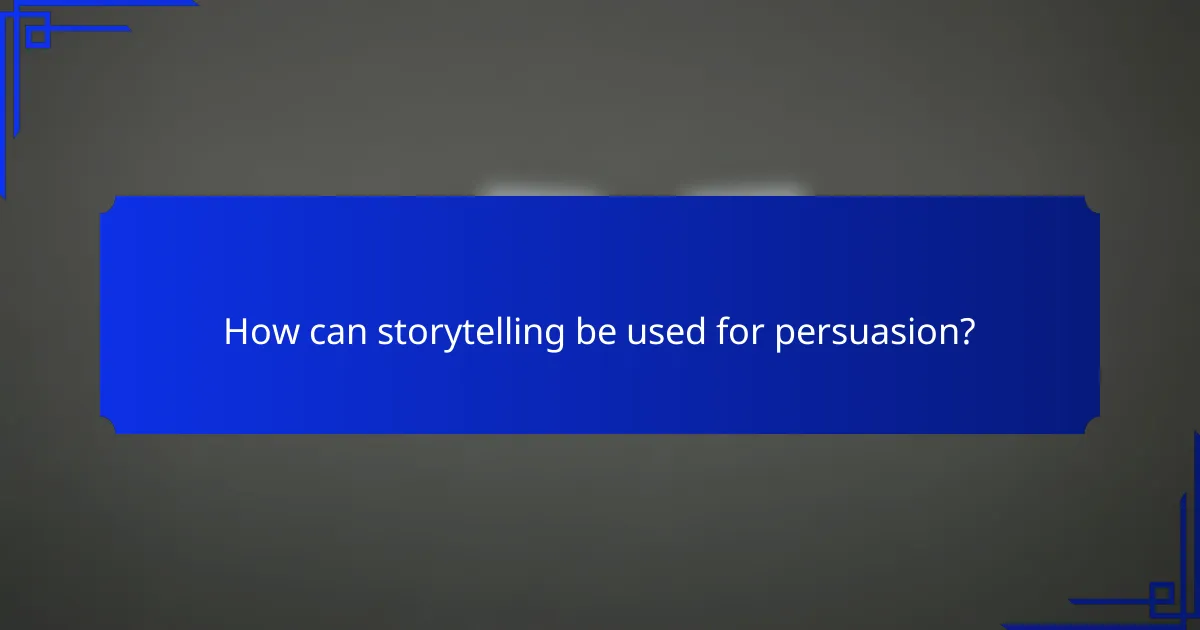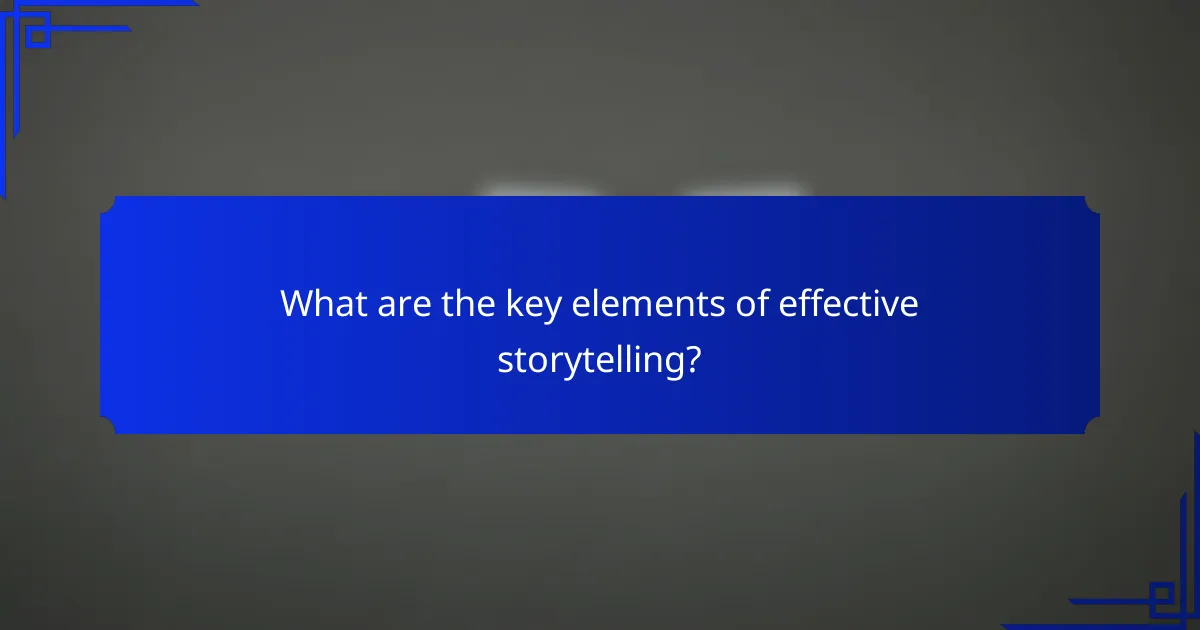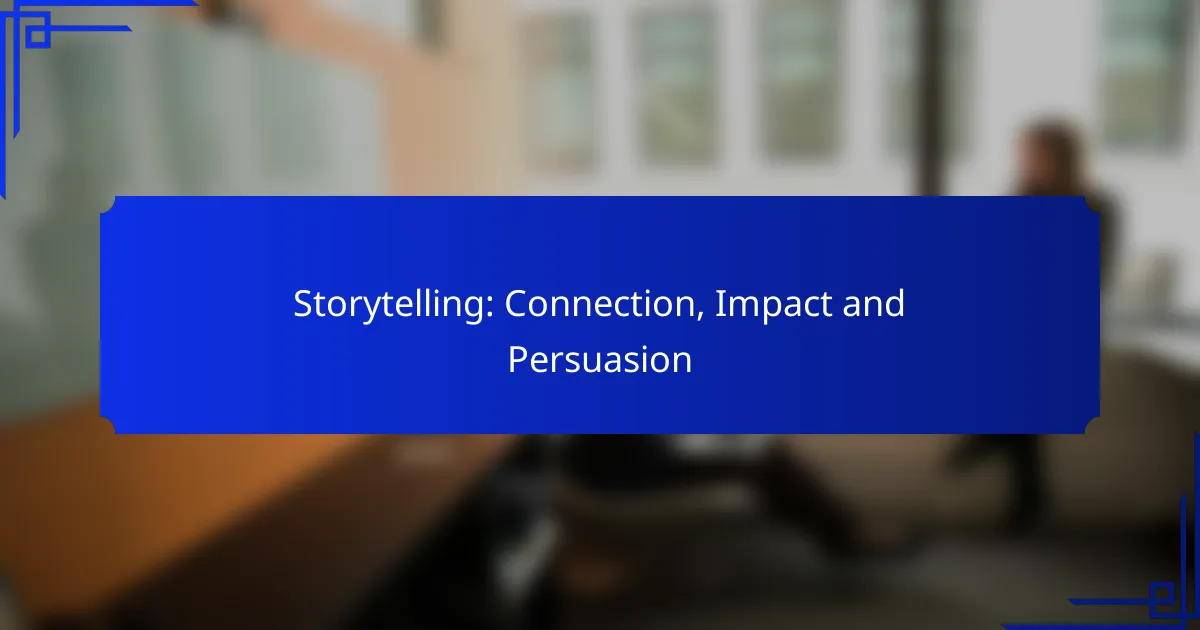Storytelling is a vital tool for creating connections and influencing audiences, as it engages emotions and fosters shared experiences. By weaving relatable narratives, storytellers can enhance understanding and drive engagement, making their messages resonate more deeply. This powerful form of communication not only strengthens interpersonal bonds but also serves as an effective means of persuasion, inspiring action and shaping opinions.

How does storytelling create connections?
Storytelling creates connections by engaging audiences emotionally and fostering a sense of shared experience. Through relatable narratives, individuals can find common ground, which strengthens interpersonal bonds and enhances understanding.
Emotional engagement
Emotional engagement is crucial in storytelling as it taps into the audience’s feelings, making the narrative more impactful. When stories evoke emotions such as joy, sadness, or empathy, they resonate on a deeper level, encouraging listeners to connect personally with the content.
For example, a story about overcoming adversity can inspire hope and motivation, prompting the audience to reflect on their own challenges. This emotional resonance can lead to stronger connections between the storyteller and the audience.
Shared experiences
Shared experiences in storytelling allow individuals to relate to one another through common themes or situations. When a story reflects familiar circumstances, it fosters a sense of belonging and community among listeners.
Consider a narrative about family traditions during holidays; many people can relate to such experiences, which can spark conversations and connections. This shared understanding helps build a collective identity among the audience.
Building trust
Building trust through storytelling involves authenticity and transparency in the narrative. When storytellers share personal anecdotes or genuine experiences, it creates a sense of reliability and credibility.
For instance, a brand that shares its origin story, including struggles and successes, can foster trust with its customers. This trust is essential for long-term relationships, as audiences are more likely to engage with those they feel they can trust.

What is the impact of storytelling on audiences?
Storytelling significantly influences audiences by creating emotional connections, enhancing understanding, and driving engagement. It serves as a powerful tool for communication, allowing messages to resonate more deeply and effectively with listeners.
Influencing behavior
Storytelling can effectively influence audience behavior by tapping into emotions and values. When a narrative aligns with the audience’s beliefs, it can motivate them to take specific actions, such as making a purchase or supporting a cause.
For instance, a charity campaign that shares a compelling story about a beneficiary’s struggles can inspire donations. Marketers often use storytelling to create relatable scenarios that encourage consumers to change their habits or preferences.
Enhancing memory retention
Stories enhance memory retention by providing context and emotional engagement, making information more memorable. People are more likely to remember facts and figures when they are embedded within a narrative framework.
Research suggests that narratives can improve recall rates by up to 60% compared to non-narrative formats. For example, a teacher using storytelling to explain complex concepts can help students retain information longer than traditional methods.
Driving brand loyalty
Storytelling fosters brand loyalty by creating a strong emotional connection between the brand and its customers. When consumers resonate with a brand’s story, they are more likely to develop trust and a sense of belonging.
Brands like Nike and Apple effectively use storytelling to convey their values and mission, which strengthens customer loyalty. Engaging narratives about product origins or customer experiences can turn casual buyers into lifelong advocates.

How can storytelling be used for persuasion?
Storytelling can be a powerful tool for persuasion by engaging emotions, creating connections, and reinforcing messages. By weaving narratives that resonate with the audience, storytellers can influence opinions and inspire action.
Crafting compelling narratives
Compelling narratives are structured to capture attention and maintain interest. Start with a strong hook that draws the audience in, followed by a clear progression of events that build tension and lead to a resolution. Use vivid imagery and relatable scenarios to make the story memorable.
Consider the classic structure of beginning, middle, and end. This format helps audiences follow the narrative easily and understand the key message. Aim for clarity and coherence to ensure the story remains focused on the persuasive goal.
Utilizing persuasive techniques
Incorporating persuasive techniques enhances the effectiveness of storytelling. Techniques such as emotional appeals, logical reasoning, and credibility can significantly impact how a story is received. For instance, using statistics or expert testimonials can bolster the narrative’s authority.
Additionally, employing rhetorical devices like repetition and metaphors can reinforce key points and make them more relatable. Be mindful of the audience’s values and beliefs, tailoring the message to resonate with their perspectives for greater impact.
Creating relatable characters
Relatable characters are essential for effective storytelling, as they allow the audience to see themselves in the narrative. Develop characters with realistic traits, struggles, and aspirations that reflect the audience’s experiences. This connection fosters empathy and makes the message more persuasive.
Consider using archetypes that resonate universally, such as the hero, mentor, or underdog. These familiar roles can help audiences quickly identify with the characters and become more invested in their journey, ultimately enhancing the persuasive power of the story.

What are the key elements of effective storytelling?
Effective storytelling hinges on several key elements that enhance connection, impact, and persuasion. These elements include structure and flow, character development, and conflict and resolution, each playing a crucial role in engaging the audience and conveying the intended message.
Structure and flow
A well-defined structure and smooth flow are essential for guiding the audience through the narrative. Typically, stories follow a three-act structure: setup, confrontation, and resolution. This framework helps maintain clarity and keeps the audience engaged by building anticipation.
Consider using techniques like foreshadowing and pacing to enhance flow. For example, varying sentence lengths can create tension or relief, while strategic placement of plot points can maintain interest. Aim for a balance that keeps the audience invested without overwhelming them.
Character development
Character development is vital for creating relatable and memorable figures within the story. Well-rounded characters should have distinct personalities, motivations, and arcs that evolve throughout the narrative. This depth allows the audience to form emotional connections, making the story more impactful.
To develop characters effectively, consider their backstory, desires, and flaws. Use dialogue and actions to reveal their traits organically. For instance, a character’s response to a challenge can illustrate their growth or highlight their struggles, enhancing the overall narrative.
Conflict and resolution
Conflict drives the narrative forward and keeps the audience engaged. It can be internal (within a character) or external (between characters or forces), and it creates tension that demands resolution. A compelling conflict should be relatable and significant to the characters involved.
When crafting resolutions, aim for satisfying conclusions that address the central conflict while allowing for character growth. Avoid overly simplistic endings; instead, consider leaving some questions unanswered to provoke thought. This approach can resonate with audiences and encourage deeper reflection on the story’s themes.

What tools can enhance storytelling in marketing?
Several tools can significantly enhance storytelling in marketing by providing visual, audio, and interactive elements that engage audiences. Utilizing these tools effectively can help brands convey their messages more powerfully and memorably.
Canva for visuals
Canva is a user-friendly graphic design tool that allows marketers to create stunning visuals for their storytelling efforts. With a wide range of templates, images, and design elements, it enables users to produce eye-catching graphics that can enhance social media posts, presentations, and websites.
To maximize Canva’s potential, focus on maintaining brand consistency in colors and fonts. Use high-quality images and consider incorporating infographics to present complex information clearly. Avoid cluttered designs; simplicity often leads to more impactful visuals.
Adobe Spark for video
Adobe Spark is a versatile tool for creating engaging videos that can tell a story effectively. It offers templates and easy-to-use features that allow marketers to combine images, text, and audio to produce compelling narratives in just a few minutes.
When using Adobe Spark, aim for short videos, ideally under two minutes, to retain viewer attention. Incorporate subtitles for accessibility and consider using a consistent theme or style throughout your video series to strengthen brand identity.
Storybird for interactive content
Storybird is an innovative platform that allows users to create interactive stories and visual narratives. This tool is particularly useful for engaging audiences through storytelling that encourages participation and exploration.
To effectively use Storybird, focus on creating narratives that invite user interaction, such as quizzes or branching storylines. Ensure that the content aligns with your marketing goals and resonates with your target audience. Avoid overly complex narratives that may confuse users; clarity is key to maintaining engagement.
